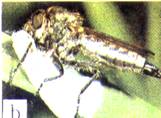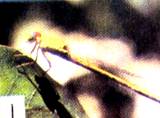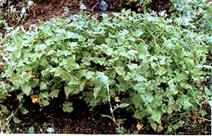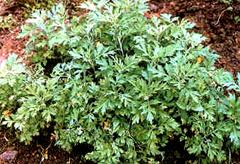| |  |  More on Disease management>> More on Disease management>> | | | | Pest Management III
| | Alternative to targeted pesticides |
The use of chemical pesticides can be minimised by integrating it with other available methods of control.
Biological control
Numerous biocontrol agents are active in tea fields exerting a natural regulation of several pests. A considerable number of natural enemies of pests of tea have been identified and some of them have been proved capable under ideal conditions of keeping the pest populations below economic threshold levels. | 
| 
| 
| 
| 
| 
| 
| 
| 
| 
| 
| 
| a. Chrysoperla | b. Robber fly | c. Orange dragon fly | d. Adult ladybird beetle (Coccinella) | e. Assassin bug sucking the juices from larva | f. Grub ladybird beetle | g. Mantis | h. Wasp | i. A mud Wasp's nest packed with larvae | j. Spider | k. Wolf Spider | l. Damsel fly |
There are two methods in the study of indigenous natural enemies:
i. Identification and augumentation and conservation of natural enemies.
ii. Mass rearing of natural enemies in laboratories and releasing against pest at frequent intervals.
| A
single ladybird can devour an entire
colony of thrips or mites in a day.
Collection and subsequent release
of ladybirds in badly infected areas
has given excellent result. The
areas have shown almost complete
recovery within 45 days followed
by prolonged mite free period. Similarly
a spider can kill five hoppers in
a day. The aphid, Toxoptera aurantii
is naturally controlled by syrphid,
coccinellid and hemerobiid predators
and aphidiid parasitoids. The braconid,
Apanteles aristacus Nixon, is the
principal parasitoid of Cydia leucostoma.
Sympiesis dolichogaster Ashmead,
is the major natural enemy of leaf
roller, Caloptilia theivora. Biological
methods of control are not available
at present for all pests affecting
tea. However, they are in the process
of evolution and refinement.
Cover crop and living mulches
It may provide habitat for natural enemies of insects, mites and nematodes. Pests may be supressed through antagonistic or allelopathic effect, or by preferential attraction to the cover crop over the desired crop. Microbial agents
It includes bacteria, fungi, viruses, protozoa, and nematodes that are pathogenic or antagonistic to pest species, including insects, plant pathogens and weeds. Pathogens can cause epizootics in pest populations, especially caterpillars. Encouraging results were obtained with introduction of Bacillus thuringiensis (Bt) against Cydia leucostoma. Bt is safe for human beings but its crystal protein produces a fatal endotoxin in the gut of the target caterpillar pests. A fungus Paecilomyces tenuipes (Peck) Samson was recorded in tea estates of Darjeeling parasitising pupal stage of various Psychid pests (Basket worm) of tea during early June to late October. B. bassiana, an entomopathogenic fungus isolated from membracid bug, a shade tree pest, was tested against Helopeltis in Darjeeling provided 49 % control by spraying 20 % suspension for two rounds at 15 days intervals. Pest resistant clones
It would provide inexpensive, environmentally sound, and highly effective way to avoid pest problems. Even low levels of resistance are important since the need for other control methods can be reduced. Different cultivars of tea with varying growth habits differ in their resistance, tolerance and susceptibility to pests. |



 |
Botanical
insecticides
These are derived from extractions,
pressing, infusions, pulverizing,
etc and they come from any plant
part. The fact they are plant derived,
however, does not distinguish them
from other pesticides by virtue
of their use, mode of action, chemistry,
formulation toxicity safety, efficacy,
marketability, or overal utility.
Neem has been found to have multifarious
properties like antifeedant, repellent,
toxicant, growth inhibitor, antiovipository
etc. The bio-efficacy of neem oil
(NO) and neem seed kernel powder
(NSKP) against sucking pests have
been observed in a field trial conducted
in Darjeeling.NO and liquid soap
at 1% concentration offered best
control followed by NSKP 100 gm
treatment. The average cost benefit
ratio was 1: 2.13. It was also observed
various plants exhibiting insecticidal
activity which could be effectively
utilized for the control of specific
type of pests. The antifeedant properties
of the extracts derived from the
aerial parts (leaves and stem) of
Artimisia vulgaris Linn.
Urtica dioica Linn. Polygonum
runcinetum Ham. and Eupatorium
glandulosum Linn. which are
at home in Darjeeling hills were
evaluated in the laboratory against
bunch caterpillar, Andraca bipunctata.
The maximum antifeedant action was
exhibited by the extract of A.
vulgaris followed by P.
runcinatum, U. dioica
and E. glandulosum. The
problem associated with much-hailed
botanicals and biopesticides is
their varying degrees of sucesses
in the field situation. Actually
while a sector of scientific community
advocates in favour of them reporting
their superiority in laboratory
trials, others demonstrated their
inefficiency in many-a-field trials. | | |
Cultural control
This, probably the most economical and widely applicable method of pest control. In tea, routine cultural operations such as mulching, plucking, pruning, manuring, regulation of shade and drainage which increase the vigour of the bush plays a predominant role in suppression of pests. Infestation by mites and thrips is seen more in tea fields devoid of shade. The heavily shaded and moist areas will be damaged more by tea mosquito bug. Leaf folding caterpillars during plucking can be manually removed. A few rounds of black plucking reduce the incidence of thrips, Helopeltis etc. Weeds serve as alternate hosts for many tea pests. Effective weed control assumes greater significance in the management of tea mosquitoes. Further, the insect pests are also removed by plucking, skiffing and pruning. These operations are assumed to strongly affect the population of insect pests on new shoots. Balanced nutrition helps improves vigour of plants to withstand pest attack.
|
Semiochemicals, including pheromones, allomones, kairomones
Another approach for controlling pests is to modify their behaviour by exploiting their natural chemical communication or feeding cues. Semiochemicals are non-toxic behaviour modifying a mixture of chemical compounds released from exocrine glands of insects such as sex pheromones, used by insect females to attract their mates, and antifeedants which may be based on the compounds produced by plants. The pheromones, in general, do not find a place in pest control in tea in India. However, in many moth species the females releases pheromones (odours) and in response males fly up wind to find them. For some species these compounds have been identified and synthesized. Such pheromones have been used mainly for monitoring populations, for disrupting mating, for mass trapping, and for lure and kill.
The allelochemicals such as kairomones and allomones produced by plants and herbivores may help in enhancing natural enemy activity and may find a role in integrated pest management (IPM) in tea as well.
Insect growth regulators (hormones) can be effectively employed for adverse modification of the normal growth and behaviour of tea pests. Growth regulators like dimilin found to be biologically effective to hinder the normal growth of caterpillars and full grown larvae of bunch caterpillars fails to pupate. The chitin inhibitor, diflubenzuron had been field tested for the management of Cydia leucostoma of tea.
Oil,
soap and other fatty acids
These are effective and have less
impact on human health and wild life
than synthetic organic chemicals.
The spray of lemongrass (Cymbopogon
citratus and C. nardus) oil and other
vegetable oil had good control over
some tea pests. |
Integrated
Pest Management (IPM)
It comprises strategies aimed at
minimising pest damage through the
careful integration of available
pest control technologies. IPM is
a pest management system that in
the context of associated environment
and the population dynamics of the
pest species, utilizes all suitable
techniques and methods in as compatible
a manner as possible and maintains
pest populations at levels below
those causing economic injury. It
is not simply the juxtaposition
or superimposition of two control
techniques (such as chemical and
biological controls) but integration
of all suitable management techniques
with the natural regulating and
limiting elements of the environmen.
In IPM system when pesticide application
is inevitable the following tips
are important to keep the residue
below MRL.
•
Keep vigilance on pest incidence.
Proper identification of pest, their
developmental stages, site of attack,
damage symptoms etc are necessary
for selection of right pesticides.
In case of combined infestation
of red spider, pink and purple mites,
recommended acaricides may be used.
But combined infestation with scarlet
mites, sulphur should be avoided
as it has no effect on scarlet mite.
However, recommendations issued
by the Tea Research Institutes should
be consulted for the right choice
of pesticide and their dosage.
•
Monitoring of the incidence and
build up of pests, for example,
tea mosquitoes, green fly, red spider,
can show initial build up in the
month of January-February in north
east India. If initial build up
is not controlled, repeated rounds
of spraying can not be avoided during
cropping season.
• Biological information
- critical time for taking up control
measures and economic threshold
will have to be determined. Damage
threshold limits have been established
in India for mite pest (Banerjee,
1971b), in China for tea looper,
tea Jassid, pink mite, leaf rollers,
tussock moth and the black aphid
(Chen and Yin, 1988) and in Sri
Lanka for the plant parasitic nematodes
(Gnanapragasam and Herath, 1989).
•
Identification of alternate hosts
of pests and where possible use
them as trap crop. Plant species
which is preferred for oviposition
by particular insect can be utilised
as trap crop.
•
Apply pesticides only when it is
absolutely necessary.
•
Proper supervision during spraying
is important. Often, in absence
of supervision, the operators may
tend to over apply the pesticides
at places and complete the job/task
expeditiously. Such application
may bound to carry residues in plucked
leaves. Supervision is therefore
must.
•
Soil stirring during the cold weather
reduces the incidence of caterpillars,
thrips, termites, cockchafer grubs
etc.
•
Bush health and hygiene is prerequisite
for good crop protection. It may
be of little use to adopt control
measures if, for example, the soil
is not prepared well or soil fertility
is low or unbalanced. Many crop
pests affect primarily weakened
plants. It is therefore, important
to aim for a healthy bush by proper
tillage, planting of proper clone
at the right time, appropriate spacing
and providing sufficient water/moisture
and nutrients. A healthy bush can
compensate pest damage by growing
new shoots or spreading up the growth
of undamaged parts.
•
Alkaline washing of pruned bushes
reduces pest incidence. The alkaline
solution (washing soda 6 kg, quick
lime2-3 kg and water 100 litre)
may be kept for overnight and strain
by using cheese cloth. The strained
solution may be applied to the frame
by using a hand operated sprayer
fitted with nozzle size 40.
•
Use of pesticides on rotation. Synthetic
pyrethroids should not be used repeatedly
or at frequent intervals.
•
Allow a minimum gap of eight to
ten days between insecticide/acaricide
application and plucking.
•
Use of conventional sprayer is preferable.
|
|
| |
|
|
|
|